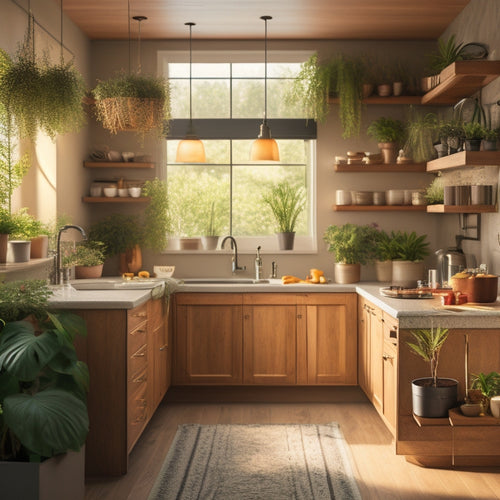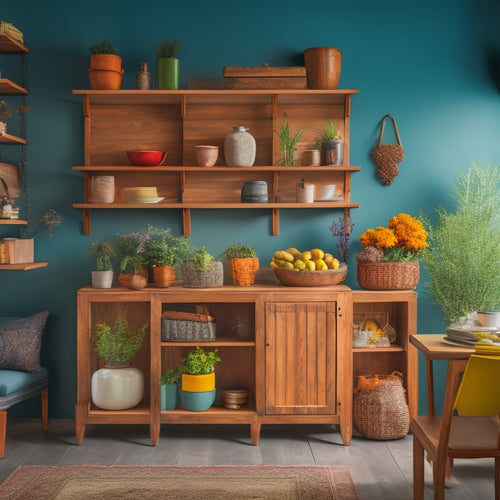
What Kitchen Design Accommodates Special Diets Best?
Share
You can create a kitchen that effortlessly accommodates special diets by incorporating tailored storage, prep, and cooking arrangements that cater to specific dietary needs and preferences. A well-planned layout is essential, with dedicated zones for food preparation, cooking, and cleaning. Allocate space for specialized appliances and storage solutions for unique ingredients. Consider food allergy safety measures, such as clear labeling and dedicated storage for allergen-free foods. By customizing your kitchen to accommodate diverse nutritional needs, you'll be able to prepare healthy meals with ease - and that's just the starting point for a culinary experience that's tailored to your specific needs.
Key Takeaways
• A well-planned kitchen layout with tailored storage, prep, and cooking arrangements accommodates special dietary needs effectively.
• Designate specific zones for food preparation, cooking, and cleaning to minimize cross-contamination risks and optimize workflow.
• Incorporate specialized tools, storage solutions, and appliances to cater to unique dietary requirements, such as gluten-free or allergy-friendly options.
• Allocate space for meal planning and tracking to ensure efficient organization and accessibility of ingredients and nutrients.
• Optimize counter space with minimalist storage solutions and strategic appliance placement to facilitate a smooth workflow.
Designing for Dietary Restrictions
When designing a kitchen for special diets, you'll need to take into account the specific requirements of the individuals who'll be using the space, as certain dietary restrictions call for tailored storage, prep, and cooking arrangements.
A well-planned kitchen layout is essential to accommodate dietary restrictions, ensuring that everything is within easy reach and minimizing cross-contamination risks. For instance, if someone has a gluten intolerance, you may want to dedicate a specific area for gluten-free food preparation and storage.
To cater to diverse dietary needs, consider incorporating specialized tools and storage solutions. For example, a kitchen designed for vegan or vegetarian diets might include a separate prep area for plant-based ingredients, while a kitchen for individuals with severe food allergies may require separate storage for common allergens like nuts or shellfish.
Space for Specialized Appliances
When designing a kitchen for special diets, you'll want to allocate space for specialized appliances that cater to your specific needs.
This might involve creating a dedicated gluten-free zone or finding clever storage solutions for appliances like spiralizers or food dehydrators.
Dedicated Gluten-Free Zone
You'll want to allocate a dedicated gluten-free zone in your kitchen, ideally with its own set of specialized appliances, to guarantee cross-contamination is minimized and cooking for gluten-free diets is made easier. This designated prep area will provide a safe space for food preparation, allowing you to confidently cook gluten-free meals.
Consider incorporating storage solutions specifically designed for gluten-free ingredients and cooking essentials, keeping them separate from other kitchen items.
A well-designed gluten-free zone can also serve as an allergy-friendly kitchenette, providing a self-contained cooking space that reduces the risk of cross-contamination. This dedicated area can be equipped with appliances and tools that cater specifically to gluten-free cooking, such as a separate toaster, blender, or stand mixer.
Appliance Storage Solutions
To guarantee your gluten-free zone remains organized and functional, consider investing in appliance storage solutions that can accommodate specialized appliances, such as a dedicated gluten-free toaster or blender, keeping them easily accessible and out of the way when not in use.
Here are some ideas to create a seamless storage system:
-
Vertical storage: Install shelves or cabinets that go up to the ceiling to maximize storage space and keep appliances out of the way.
-
Hidden compartments: Design a cabinet with a hidden compartment to store small appliances, like a gluten-free toaster, keeping it out of sight but still accessible.
-
Slide-out appliance garages: Incorporate a slide-out appliance garage into your design, allowing you to easily access and store appliances like blenders or food processors.
Storage for Unique Ingredients
When designing a kitchen for special diets, you'll need to contemplate storage solutions that accommodate unique ingredients.
You'll want to ponder how to maximize your storage space to keep specialty items within easy reach.
Specialty Pantry Shelves
Designing a kitchen for special diets often requires incorporating specialty pantry shelves that can accommodate unique ingredients, such as gluten-free flours or vegan alternatives, which may have different storage needs than traditional pantry staples. You'll want to think about customized organization solutions that cater to your specific dietary requirements.
When planning your pantry, ponder the following features:
-
Adjustable shelves: to accommodate different sizes and shapes of specialty ingredients, such as large bags of gluten-free flours or small containers of vegan sauces.
-
Separate compartments: to store allergen-free foods in a dedicated area, preventing cross-contamination with other ingredients.
-
Easy-to-clean surfaces: to make sure that your pantry stays hygienic and free from residue, making it safe for food preparation.
Dedicated Spice Stations
You'll likely need dedicated spice stations to keep unique ingredients, such as specialty salts or gluten-free seasonings, within easy reach and organized for efficient meal prep. This is especially significant when managing special diets, where incorrect ingredient usage can have serious consequences.
A well-designed spice station guarantees that you can quickly access the ingredients you need, reducing the risk of mistakes.
Proper spice organization is essential for meal preparation, as it saves time and reduces stress. With a dedicated spice station, you can easily find the ingredients you need, and avoid contaminating other foods with allergens or incompatible ingredients. This is particularly significant for individuals with severe food allergies or intolerances.
Customized Cabinet Inserts
Customized cabinet inserts provide a tailored solution for storing unique ingredients, ensuring that gluten-free flours, vegan alternatives, or other specialty items are neatly organized and easily accessible within your kitchen. This thoughtful design element is particularly important for individuals with specific dietary needs, as it allows you to maintain a high level of pantry organization and keep track of dietary labels.
Here are a few ways customized cabinet inserts can benefit your kitchen:
-
Clear categorization: Designate specific inserts for gluten-free, vegan, or other dietary-specific ingredients, making it easy to identify and access the items you need.
-
Efficient storage: Maximize your cabinet space by storing items like nut flours, alternative milks, or specialty oils in designated inserts, keeping them fresh and within reach.
-
Visual inventory: At a glance, you can see what ingredients you have on hand, making meal prep and planning more efficient and safe, especially when managing allergen safety.
Efficient Workflow for Meal Prep
By streamlining your kitchen workflow, you can shave precious minutes off meal prep time, making it easier to accommodate special diets. A well-designed kitchen layout can help you stay organized and focused, reducing the risk of mistakes and increasing your overall efficiency.
To maximize your meal prep workflow, consider the following strategies:
| Task | Time-Saving Technique | Organization Tip |
|---|---|---|
| Meal Planning | Plan meals for the week ahead of time | Keep a meal planning calendar on the fridge |
| Grocery Shopping | Make a list and stick to it | Organize your pantry and fridge by food type |
| Food Prep | Chop ingredients in bulk | Store prepped ingredients in labeled containers |
Accommodating Food Allergy Safety
Designing a kitchen that accommodates food allergy safety requires careful consideration of cross-contamination risks, dedicated storage, and clear labeling to guarantee safe meal prep for individuals with life-threatening allergies. You'll want to focus on creating an environment that minimizes the risk of accidental exposure to allergens.
To achieve this, consider the following essential elements:
-
Allergy-friendly surfaces: Choose countertops, tables, and appliances with smooth, easy-to-clean surfaces that won't harbor allergens.
-
Storage solutions: Designate specific areas for storing allergy-friendly foods and ingredients, keeping them separate from other foods.
-
Clear labeling: Use color-coding, labels, or signs to clearly identify which foods contain common allergens, such as peanuts, gluten, or dairy.
Customizing for Nutritional Needs
When planning a kitchen for special diets, you'll need to tailor your space to accommodate specific nutritional requirements, whether it's a low-sodium diet for heart health or a high-protein regimen for athletic performance. This means considering how you'll store and prepare ingredients to meet those needs.
Effective meal planning is vital, so designate a specific area for planning and tracking meals. This could be a chalkboard or whiteboard for jotting down recipes and grocery lists, or a built-in desk for laptop-based meal planning.
Ingredient organization is also key. Consider a pantry or cabinet system with labeled bins and baskets to store specific ingredients, such as gluten-free flours or low-sodium spices. This will help you quickly identify and access the ingredients you need for each meal.
Additionally, think about incorporating features like a built-in nutrition facts reference guide or a kitchen scale to guarantee accurate measurements. By customizing your kitchen to meet your nutritional needs, you'll be better equipped to manage your diet and achieve your health goals.
Maximizing Counter Space Efficiency
You'll need to optimize your counter space to efficiently prepare and cook meals that meet your specific dietary requirements. A well-designed kitchen with ample counter space can make a huge difference in your ability to manage your special diet.
To maximize counter space efficiency, consider the following:
-
Minimalist storage: Install shelves, cabinets, or drawers that are strategically placed to keep frequently used items within easy reach, while storing less frequently used items out of the way.
-
Streamlined organization: Designate specific zones for food preparation, cooking, and cleaning to minimize clutter and reduce the risk of cross-contamination.
-
Functional layout: Position your most-used appliances, such as a stand mixer or slow cooker, in a way that creates a smooth workflow and allows for easy access.
Frequently Asked Questions
What Are the Most Common Dietary Restrictions in Kitchen Design?
You'll often encounter clients with dietary restrictions, including Low FODMAP and Paleo diets, as well as those requiring nut-free and dairy-free environments.
Can a Kitchen Accommodate Both Gluten-Free and Vegan Diets?
You can easily accommodate both gluten-free and vegan diets by implementing dedicated meal planning, storage, and cooking utensils, as well as separate appliances, to guarantee safe food preparation and minimize cross-contamination.
How Do I Ensure Cross-Contamination Prevention in My Kitchen?
To guarantee cross-contamination prevention, you separate, categorize, and contain; label gluten-free and vegan foods, store them in designated zones, and clean surfaces frequently, prioritizing food safety and organization in your kitchen.
Are There Any Smart Home Integrations for Special Diets?
You can explore smart home integrations that cater to special diets, such as smart appliances that assist with meal planning, automatically generating shopping lists and recipes based on your dietary needs and preferences.
Can I Still Have a Beautiful Kitchen With Special Dietary Needs?
You can have a kitchen that's a stunning masterpiece, effortlessly accommodating your dietary needs! With clever kitchen organization and functional, stylish design, you'll be whipping up safe, delicious meals in no time, without sacrificing an ounce of style.
Related Posts
-

Revolving Cabinet Organizer Lazy Susan
A revolving cabinet organizer like a Lazy Susan is a transformative solution for your kitchen. It maximizes space and...
-

Space-Saving Kitchen Island Storage Hacks
You can change your small kitchen into a functional haven with clever space-saving island storage hacks. Start by ins...
-

Creative Corner Cabinet Space Management
Creative corner cabinet space management turns neglected nooks into stunning storage solutions. You can maximize vert...


